Lead Photo Credit: Daniel Bernhardt
The 1RM Trap-Bar Deadlift Test
As a serious lifter, you should be able to pass this test:
Set up a trap bar with 2.5 times your bodyweight. Now, get one good rep. That's it. So, a 200 pound man should try to hit a 500 pound trap-bar deadlift.

Trap-bar deadlifts aren't inherently "better" for testing strength than traditional squats or deadlifts, but they have a number of unique benefits.
Squats are mostly knee-dominant, with some help from the posterior chain. Deadlifts are mostly hip-dominant, with some help from the anterior chain. There's definitely overlap between the two, but it's hard to determine who's stronger: a guy with a 500 pound squat and a 400 pound deadlift, or a guy with a 400 pound squat and a 500 pound deadlift.
A trap-bar deadlift can settle the debate. It's a hybrid movement that combines the best of the squat pattern with the best of the hinge pattern.
Rather than focusing on one side of the body, it requires a great deal of strength from both the posterior and anterior chain. On top of recruiting the entire musculature of the lower half, trap-bar deadlifts require significant upper back and grip strength.
Plus, no lift translates more directly to overall athleticism and performance like the trap-bar deadlift. For example, a vertical jump requires exerting maximum force into the ground, which is exactly what it takes to lift a maximally loaded trap bar off the floor.
Can't Do It?
Make trap-bar deadlifts your primary strength focus on lower-body days. Squats and conventional deadlifts obviously help, but nothing boosts your trap-bar deadlift more than the lift itself. Heavy singles, sets of 3-5 reps, and dynamic effort sets with bands or chains will go a long way.





